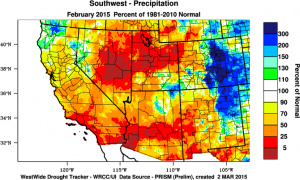With a dry February, the chances of a big snowpack and “bonus water” flow in 2015 that might begin to refill Lake Mead and Lake Powell are just about gone.
April-July runoff into Lake Powell, the big reservoir in the Colorado River’s “Upper Basin”, is forecast to be 71 percent of average, according to the Colorado Basin River Forecast Center. There’s still a one in ten chance, if things get wet over the next month, that we could have an average year. But with another lost month, the chances on the wet side of the probability distribution no longer leave much room for enough excess runoff to bail out the river system’s shrinking reservoirs.
On the bad side, the “one in ten” forecast on the dry side, the worst case scenario, is for 48 percent of average.
As you can see from the map to the right, February was wet up in the state of Colorado, but if your interest is in Colorado River runoff, it was not wet in the right places. That blue blob is on the eastern slope and the plains. The high mountains and west slope were drier than normal, which translates into less runoff into Lake Powell.
I’m waiting on more New Mexico numbers (the Rio Grande Basin) and will write a separate post when I get them, but the preliminary numbers in the San Juan headwaters, which provides San Juan-Chama water, are not good. The projected flow at the Navajo/Chromo/Oso measurement point in southern Colorado, a good proxy for overall SJC production, is 58 percent.
(Full disclosure: I foolishly entered into a bet regarding April 1 SJC supply. It’s a complicated bet involving total allocated and in storage on April 1. Suffice to say I have a cost-of-a-dinner incentive to root for more snow. Also, it’s my community’s drinking water supply.)

